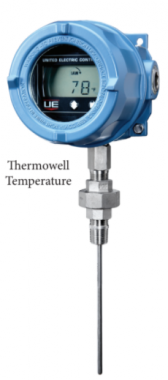Summary
This guide provides information on replacing a UE electro-mechanical switch with the digital displaying, programmable and self-diagnostic UE One Series electronic switch. Included are some of the challenges associated with Management of Change (MoC), frequently asked questions, a technology comparison and dimensional drawings – the information required to facilitate this easy and cost-effective field instrument upgrade.
Management of Change
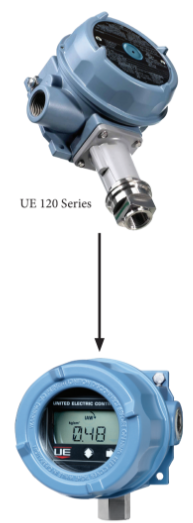
UE One Series 1XSW Shown with Gage Pressure Sensor
Management of Change (MoC) procedures were born out of the need to document design changes to process control and monitoring equipment. When a field instrument requires replacement, for example, an effort is made to utilize the same instrument type and model, otherwise known as “replacing with like kind”. This minimizes the effect that the replacement instrument has on the process and maintains the same level of safety.
“Like kind” replacements are not always possible due to instrument availability and design changes, process changes and a desire to improve the safety level and technology. The amount of reporting and documentation needed to satisfy MoC requirements make process monitoring improvements difficult to approve and implement. Exacerbating this issue is the practice of replacing a failed instrument with the same make and model, only to have the replacement instrument eventually fail in exactly the same manner, usually due to misapplication.
An alternative instrument upgrade may be desired to increase performance and solve failure issues, but the documentation requirements for MoC may cause upgrade projects to be abandoned, preventing improvements and stifling innovation.
• What if there was an alternative to a mechanical switch that utilizes the same control scheme and 2-wire connection to the plant control system and provides the same mounting, conduit, wiring and process connections?
• What if this digital electronic switch had powerful self diagnostics, infinitely adjustable set point and headband, digital process display and required no power wiring?
The Solution
The United Electric Controls One Series 1XSW electronic switch drops in place of any mechanical pressure or temperature switch that is connected to the plant control system, PLC or DCS, including 24 VDC, 48 VDC, 120 VAC, 125 VDC and 230 VAC inputs. The One Series 1XSW uses the existing plant wiring from the mechanical switch it is replacing. No additional wiring or power is necessary. No batteries or solar panels are needed. No changes are required for the plant control scheme.
- Remove the old mechanical switch.
- Connect the same two wires to the One Series 1XSW electronic switch.
- Secure the enclosure and connection to the process. Upgrade complete!
Frequently Asked Questions
-
- Q: What mounting changes are required to replace a 120 Series with a One Series 1XSW? A: None – the One Series 1XSW uses the same 4-bolt mounting configuration.
- Q: What changes will need to be made to electrical conduit connections? A: None – The One Series 1XSW uses the same conduit entrance sizes and locations as the 120 Series.
- Q: What process piping changes will be required? A: Because of the wide variety of 120 Series sensors, this must be evaluated on a case-by-case basis. See the drawings below for specific dimensions of the One Series 1XSW mounting configurations.
- Q: What electrical wiring changes will need to be made? A: None, if the 120 Series switch is an input to a DCS, PLC or other controller. The existing two wires can be connected directly to the One Series 1XSW. If, however, the 120 Series is switching a load directly, contact UE Inside Sales to determine if any wiring changes are required.
- Q: Is the One Series 1XSW considered a dry contact switch? A: No. The One Series 1XSW electronic switch circuit will draw a slight amount of current (~0.7 mA) to power itself, far below the detection threshold of the input card.
- Q: What changes will be required to my DCS or PLC input card? A: No changes are required. The control system cannot distinguish between the One Series and a dry contact switch.
- Q: What programming changes will be required in my DCS or PLC? A: None. The One Series 1XSW can utilize the existing control scheme and can be set to be either NO or NC, equivalent to the electro-mechanical switch action of the 120 Series.
- Q: Will the One Series 1XSW only work with control system inputs? A: No. The electronic switch can also be wired in series with the coil of an interposing relay.
- Q: Are the enclosure ratings the same between the 120 Series and the One Series 1XSW? A: Yes, the One Series 1XSW can be used in the same area classifications as the 120 Series.
- Q: Will the One Series 1XSW have the same set point repeatability and deadband as the 120 Series? A: The One Series 1XSW has much tighter repeatability (0.1%) and the deadband can be adjusted 0 – 100% of sensor’s range, providing increased flexibility for new applications.
- Q: How does the One Series 1XSW price compare to a typical process transmitter? A: Considering the installed cost (wiring, programming, analog input card), the One Series 1XSW is less than 50% of the installed cost of a typical process transmitter. The cost of the upgrade is the cost of the One Series!
Dimensional Drawings
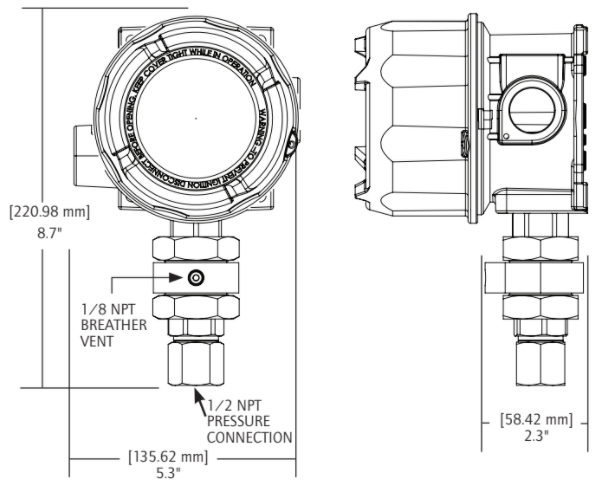
The One Series shown with Dual Seal option M041 and a gauge pressure sensor
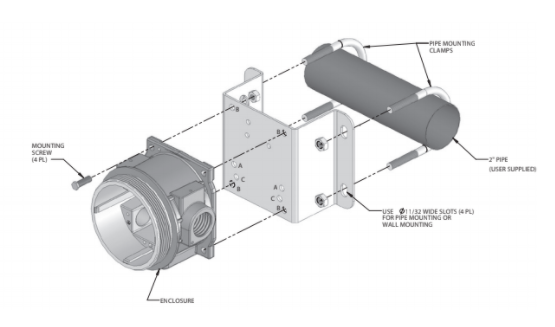
Wall or Pipe Mounting Bracket –Option M449
Temperature Sensors – 100 Ω Platinum RTD
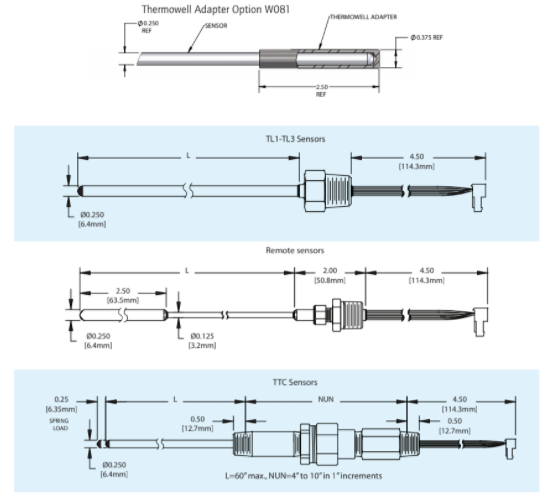
Pressure Sensors – Piezo-resistive strain gage
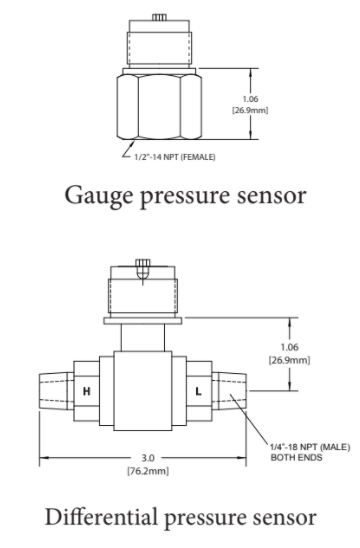
Final Analysis
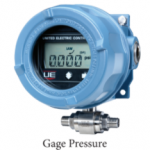 Management of Change procedures often discourages substitutions of existing field instruments due to the documentation necessary to choose alternative technologies. Choosing devices that operate and mount in the same manner but offer many new features and uses the existing plant wiring and control scheme may satisfy “replace with like kind” requirements.
Management of Change procedures often discourages substitutions of existing field instruments due to the documentation necessary to choose alternative technologies. Choosing devices that operate and mount in the same manner but offer many new features and uses the existing plant wiring and control scheme may satisfy “replace with like kind” requirements.
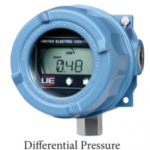 When replacing an electro-mechanical pressure or temperature switch that is connected to the plant control system, United Electric Controls offers the One Series 1XSW electronic switch. This device obtains power from the control system input that it is connected to while providing a solid-state on/off discrete switch signal, the same as expected from a mechanical dry-contact switch. The One Series incorporates a programmable set point and deadband, digital process display and smart IAWTM self diagnostics in an explosion proof and weather tight enclosure. These features provide a quick, easy and cost-effective upgrade path from mechanical switches.
When replacing an electro-mechanical pressure or temperature switch that is connected to the plant control system, United Electric Controls offers the One Series 1XSW electronic switch. This device obtains power from the control system input that it is connected to while providing a solid-state on/off discrete switch signal, the same as expected from a mechanical dry-contact switch. The One Series incorporates a programmable set point and deadband, digital process display and smart IAWTM self diagnostics in an explosion proof and weather tight enclosure. These features provide a quick, easy and cost-effective upgrade path from mechanical switches.
